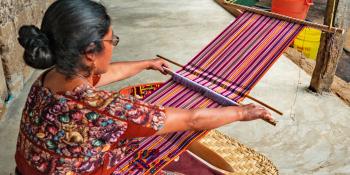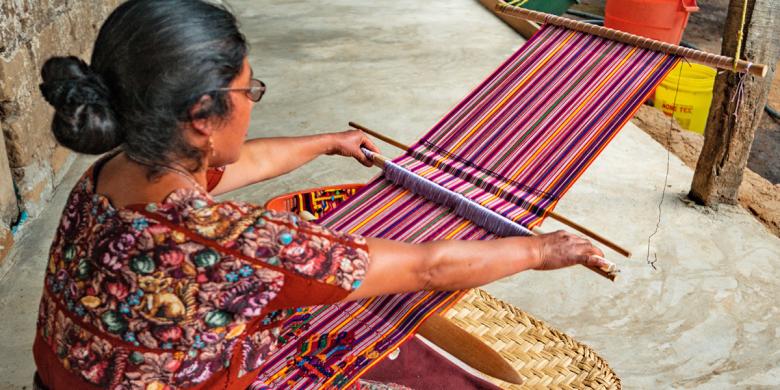
The safety of a solid floor
María Natalia lives with her husband, sister-in-law and three dogs in their home in San Juan Sacatepéquez, Guatemala. Each morning when she wakes, she prays to God and the Virgen to give thanks for a new day. Then, she cleans and tidies her house, which has a dirt floor, prepares breakfast, and begins her day of work.
Her job consists of weaving on the floor of her home. So, when María Natalia learned that she had been selected to replace her dirt floor with concrete, she was overjoyed that she would soon be able to complete her work in more ideal conditions.
“I am happy, because this floor used to be dirt and sand, so was very dusty. When I kneeled to weave, I wasn’t comfortable. My knees ached from the dirt and rocks. Also, the floor wasn’t even, so it was hard for me to weave like that. When I finished [the fabrics] they would be full of dirt and dust. But not anymore. I can see the difference. Now, they don’t get dirty, and the loom is in a different position and doesn’t move around as much,” says María Natalia.
Her family was among those selected to participate in “PISOS S3,” a pilot project launched by the Inter-American Cement Federation (FICEM) and developed in partnership with Habitat for Humanity Guatemala, Cementos Progreso, the Cement and Concrete Institute of Guatemala (ICCG) and the Network of Indigenous Entrepreneurs (REI).
The pilot focused on installing over 3,500 square feet of concrete flooring, benefiting 32 families in five Indigenous communities in the municipality of San Juan Sacatepéquez. As a holistic accompaniment to the new floors, the pilot also distributed water filters and provided the beneficiary families with training on healthy housing, operating the water filter and using and maintaining the floors.
Fueled by the pilot’s success, Habitat for Humanity and FICEM united forces to officially launch the 100,000 floors to play on initiative, which aims to replace 100,000 dirt floors with concrete in vulnerable households throughout Latin America and the Caribbean by 2028.
María Natalia’s home improvement not only represents a benefit to the development of her economic livelihood, but also has a positive impact on the health of her family.
Both she and her husband have noticed significant improvements in their health. They used to frequently come down with a cough. No longer living amidst dust and dirt, they haven’t been sick at all.
“This floor can be swept and washed. We couldn’t do that before because of the dirt and the dust”— María Natalia
“Thank you for helping us with the floor. We are happy and content. This floor can be swept and washed. We couldn’t do that before because of the dirt and the dust. We had been thinking about improving our home, but hadn’t been able to”, María Natalia concludes.

María Natalia weaves on her concrete floor. ©Habitat for Humanity Guatemala/José Ramírez.